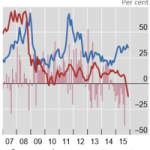Video Length: 00:07:13
Talking Points:
– EURUSD has u-turned post-FOMC, and even closed last week lower.
– USDJPY persists in triangle alongside S&P500.
– See the September forex seasonality report.
After the Federal Reserve’s non-decision last week, traders are already looking to other central banks to step up their easing efforts. While the Bank of Japan seems like an obvious choice given the country’s struggle to find consistent growth and stable inflation, market attention seems to be focusing more closely on the European Central Bank in the direct aftermath of the Fed.
While the Euro may be trading in a bit of a fog in the post-FOMC meeting world – having been pulled about thanks to the competing factors of the US Dollar decline and the bounce in risk sentiment – traders may be given plenty of fuel to reignite their bearish Euro bias over the coming days.
Indeed, against the backdrop of the ECB having already downgraded its growth and inflation forecasts at its most recent policy meeting in early-September, the three ECB Executive Board members speaking this week – Couere, Nowotny, and Praet – will have a chance to talk up the efficacy of expanding the ECB’s current QE program.
In fact, in the wake of the Fed’s non-decision last week, ECB Executive Board member Benoit Couere said that the Fed’s decision to keep rates on hold confirms the ECB’s own dour assessment for global growth. ECB Chief Economist and Executive Board member Peter Praet said last week that the ECB wouldn’t hesitate to act again if it deemed “shocks” to be longer lasting than currently anticipated (which seems possible and likely now that the Fed has held steady). Given the proximity to these comments, it’s unlikely that these ECB members change their dovish tune when they speak this week.
In any case, through its actions and words (mostly words to this point), the ECB seems to be in the early stages of greasing the skids for an expansion of its QE program past its September 2016 expiration; a chagce in the program’s scope (what bonds can be purchased), size (the run-rate of purcchases, currently at €60 billion/month), and/or duration (when the program will run to) could all prove to be materially negative for the Euro over the coming months – a re-run of early-2015 for the Euro and perhaps the US Dollar.













Leave A Comment